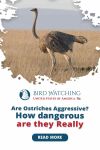
What’s This Post About?
Ostriches are known for being the largest birds. Even though their weight and size do not allow them to take flight - a significant element of being a bird - they are still regarded as one of the most powerful birds.
However, because of their behavior, size, and unpredictability, they are considered highly aggressive.
Depending on the season, ostriches can be observed alone, in couples, small flocks, or enormous groups of fifty. To avoid predators or intruding humans, the ostrich depends on its powerful legs—which are remarkable; they are two-toed, with the middle toe formed nearly like a hoof.
Ostriches become aggressive when they feel threatened. Ostriches can kill lions and other dangerous animals with their lethal forward kicks. However, kicks and slashes are rarely directed at humans, but most attacks originate from people agitating the birds.

When Are Ostriches Aggressive?
Attacks by ostriches are sporadic but not unheard of. Ostriches murder several people each year, and many more are gravely hurt. In addition, they are incredibly aggressive around predators and humans that make them feel threatened.

An ostrich’s aggression stems from vulnerability. Situations that can make these birds feel threatened or vulnerable are:
- During mating season
- During nesting period
- When the babies are born
Males become more violent during mating season, and mothers will use whatever measures necessary to defend their young. They aren’t predators, and they don’t go out in search of prey. However, if they sense any danger to themselves or their babies, they will attack.
The same goes for humans. Ostriches seldom attack humans, and it will not kill them. Instead, it will most likely leave the human alone once it no longer perceives them as a danger.
How Dangerous Are Ostriches?
When frightened, ostriches generally flee, but their robust, long legs are strong enough to kill a person or a prospective predator like a lion with a forward kick.
Ostriches live in the wild, on safaris and ostrich farms. However, wherever you encounter them, handle them with extreme caution—they’re one of the most deadly birds on the planet. They do not feed on humans, but they have been known to harm and kill people when disturbed.

Ostriches are the world’s largest bird, weighing up to 330 lb. (150 kg). They are powerful, quick, and unafraid of anything. They can be greatly dangerous with their three primary weapons that you should be wary about.
- The most deadly aspect of an ostrich is its solid legs, which can deliver a devastating blow. If they assault, they will very certainly kick you.
- Its huge, piercing claws: Ostrich talons may reach a length of up to 4 inches (10 cm). An ostrich talon is very sharp, and when paired with a powerful kick, it may disembowel a human.
- Its beak: While the beaks of ostriches are not as sharp as those of many other species, being nipped by one may nevertheless be painful. Shield your eyes and other delicate regions as much as possible.
DID YOU KNOW?
At 2,000 pounds per square inch (141 kg/square cm), one kick from an ostrich may easily kill a human.

Just to put things in perspective. Consider the study of 70 elite-level boxers that demonstrated that they could punch with an average force of 776 psi. This means ostriches can exert nearly three times the strength of a skilled boxer. And all of that effort is focused on the pointy tip of their 4′′ toenail.
Ostrich vs. Lion
People view lions as the strongest animal in the jungle. Some might even call them the king of the jungle.
Did you, however, know that ostriches are strong enough to kill lions? This is how dangerous and aggressive these birds can be. One kick from the ostrich can be forceful enough to knock the lion down.
Ostrich vs. Cheetah
One of the ostrich’s main predators is the cheetah. This is partly owing to the cheetah’s ability to match with an ostrich’s vigorous speed.
The cheetah’s tremendous speed sometimes allows it to hunt down an ostrich. But, even then, hunting an ostrich generally necessitates the use of more than one cheetah.
DID YOU KNOW?
An ostrich can run up to a speed of 70km per hour.
Are Both Domestic And Wild Ostriches Aggressive?
Both domestic and wild ostriches have been known to be aggressive towards both humans and animals. However, their violent tendencies are innate and basically the same irrespective of whether they are in captivity.

Ostriches, like any other animal, maybe both be benign and deadly based on their temperaments and inherent behaviors, as well as the circumstances.
When ostriches are attacked or trapped, their offspring or eggs are attacked, or it is breeding season, they will strike.
How Do Ostriches Attack?
Now that you know about an ostrich’s weapon, understand how they use them. Ostriches have two methods of attack: slashing and ramming. An enraged adult ostrich stomping on your body, as you might expect, will injure you, causing multiple fractures and shattered ribs.

Slash: Their foot is their most dangerous weapon. They injure the predator’s limbs or stomach area with a slash or cut. Kicking is done in a forward and downward motion. Their toenail is pointed and ranges in length from 4-6 inches (10-15 cm).
Ram and Jump: This is a more regular occurrence that may surprise you. With their bony structure, they will smash any human. The individual will be knocked down by this ram assault, which then leaps on top of them.
DID YOU KNOW?
An adult ostrich may weigh up to 320 pounds (145 kg).
How To Survive An Ostrich Attack?
If an ostrich assaults you, the best thing you can do is take shelter and hide. You can also shield yourself from the ostrich’s strong kicks and sharp claws by climbing trees. If neither of these choices is available, you’ll have to pretend dead or use a stick to fend off the approaching ostrich.

Take Shelter
Understand that you are dealing with a very powerful and fast bird, so outrunning it is not a possibility. Over open land, ostriches may reach speeds of 43 mph (70 km). The best thing you can do to evade a charging ostrich is to find cover at the nearest place.
Here are a few alternative shelter ideas:
- If there is deep vegetation or woodlands nearby that you can reach before the ostrich catches up with you, make a run for it.
- Look for a strong cover, such as a car or a man-made building that can take an ostrich’s hit. A kick from an ostrich’s leg may hit you with a force of 500 pounds per square inch.
- Rather than risking a protracted chase, choose something that hides you from its gaze. Ostriches aren’t exceptionally bright, so if they can’t see you, they’ll forget about you, lose interest, and wander away.
- Dive into a thorny bush. Instead of being brutally mauled by the ostrich’s razor-sharp claws, it is better to be wounded by thorns. The ostrich will not poke its head in the thorns at the risk of hurting itself.
- Find an elevated spot. Keep in mind that an ostrich is unable to fly. If there are no hiding spots on the ground, climb a tree, fence, or other structure.
PRO-TIP
A mature ostrich stands between 7 and 9 feet tall, so choose a higher elevation. Even though it has no teeth, it may stab at you with its beak, causing you to lose your grip.
Pretend To Be Dead
If the shelter is far away, overcome the desire to sprint for cover or elevation. Alternatively, as a very last attempt, pretend to be dead. Your stomach should be pressed to the ground. To shield your skull, wrap your hands over the back of your head.
Keep in mind that this technique may still cause significant damage. Before the ostrich deems you harmless, it might play with you or poke around to be sure. Here are a few things that the ostrich might do to you if you play dead:
- Kick you.
- Sit or stand on you. A mature ostrich can weigh anywhere from 198 to 350 pounds.
- Poke at you with its talons.
You might be wondering how playing dead is a survival technique then. This is your best shot to convince the ostrich that you are not here to attack it. If you keep running without a nearby shelter, it will catch up with you and possibly kill you.
The success of survival here lies in the positioning and lack of motion. The talons are undoubtedly a threat but lying on the back secures your organs. Also, when you lie facing downward, the chance of harm from the force of an ostrich’s kick is significantly less.
Fight Back
In the situation that you have no other option but to fight back, try to avoid confined areas. Remember that an ostrich’s main weapon is its leg to stay as far away from them as possible. Use the nearest and longest weapon you can find, such as a pole, shovel, brush, or stick.
During a direct encounter with an ostrich, you should position yourself behind or at the sides of the ostrich. It can only kick whatever is in front of it, making you the most vulnerable if you face each other.
Use the longest object you can find and aim towards the nape of the neck. This is the ostrich’s most vulnerable body portion. If that fails, go for its chest. When the chance arises, split your energy between the two. Continue striking until it gives up and flees.
If the ostrich remains adamant and does not leave despite your strikes on its neck, strike its wings. Know that an ostrich’s wings are used to change direction more seamlessly when running, similar to a ship’s rudder. Hence, damaging the wings can help you escape if need be.
Given the circumstance and opportunity, take a shot at one of the ostrich’s legs. You should be aware that the ostrich’s center of gravity is dependent on its two slender legs. Strike it with one or both of your hands to throw off its equilibrium, mobility, and striking strength.
How To Avoid An Ostrich Attack?
Even with prior knowledge of techniques surviving ostrich attacks are not that simple. The best way to survive an attack would be to prevent it from happening in the first place. Avoid going to places where ostriches reside or approaching them, especially during seasons they feel most threatened.

Stay Aware Of Your Surrounding
When you’re in an area where ostriches could live, have a look around, avoid being in open spaces without any possible shelters, stick close to cover and make a mental note of which locations would be the safest to flee to just in case an ostrich charged at you.
Do Not Approach The Bird

When you see an ostrich in the wild, keep your distance. Even though the ostrich looks to be calm, stay away if it approaches you. Remember that any distance shorter than 110 yards is considered too near. Also, do not let online pictures of people kissing or petting the bird fool you.
Be Mindful Of The Seasons

As previously mentioned, ostriches are extra vulnerable during mating and breeding seasons. Even though you should not approach ostriches at any time, these seasons are particularly dangerous.
You may be wondering how to figure out when ostriches are breeding! Identify breeding season by the appearance of flocks of 5 to 50 ostriches at a time, while ostriches usually travel in couples or alone during other seasons of the year.
Expect males to be responsible for defending the female’s eggs at their most readily agitated behavior during this period. Males may be distinguished by their black feathers, white wingtips and tail plumes, and a crimson tinge on their front legs.

Keep Reading!
Ostriches may become violent when they feel trapped or to defend their babies or territory. Similar behaviors have been observed in wild or domesticated ostriches, which have retained their original instincts and react aggressively under stress occasionally.
Ostriches strike with their strong feet, equipped with long claws capable of killing a human with a single stroke. Now that you know all about an ostrich’s aggression, read to learn more about if a duck can be aggressive.
Are Ducks Aggressive or Territorial? Will They Bite You?
Ducks are less likely to bite, however, you are at risk of being bitten if your duck shows some warm signs. Is your duck aggressive? Find out!

By David A. Swanson
Bird Watching USA
My name is David and I'm the the founder of Bird Watching USA! I started Bird Watching with My father-in-law many years ago, and I've become an addict to watching these beautiful creatures. I've learnt so much over about bird watching over the years that I want to share with the world everything I know about them!

David A. Swanson
Bird Watching USA
My name is David and I'm the the founder of Bird Watching USA! I started Bird Watching with My father-in-law many years ago, and I've become an addict to watching these beautiful creatures. I've learnt so much over about bird watching over the years that I want to share with the world everything I know about them!



